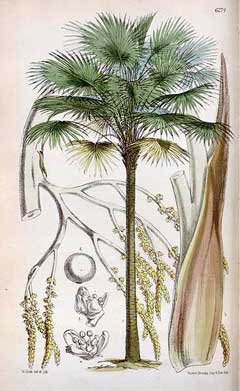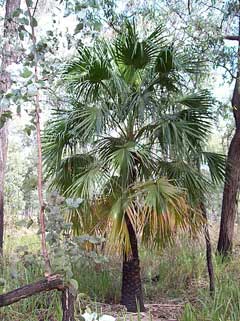 |
|
http://commons.wikimedia.org/wiki/File:Livistona_australis01.jpg |
 |
| http://picasaweb.google.com/lh/photo/qGFSfzGw_ko6fHGNDw3DjQ |
Translate this page:
Summary
Bloom Color: Yellow. Main Bloom Time: Early summer, Early spring, Late summer, Late spring, Mid summer, Mid spring. Form: Palm.
Physical Characteristics

 Livistona australis is an evergreen Tree growing to 20 m (65ft) by 6 m (19ft) at a slow rate.
Livistona australis is an evergreen Tree growing to 20 m (65ft) by 6 m (19ft) at a slow rate.
See above for USDA hardiness. It is hardy to UK zone 10 and is frost tender. It is in leaf all year. The species is hermaphrodite (has both male and female organs) and is pollinated by Insects.
Suitable for: light (sandy), medium (loamy) and heavy (clay) soils. Suitable pH: mildly acid, neutral and basic (mildly alkaline) soils. It can grow in semi-shade (light woodland) or no shade. It prefers dry or moist soil.
UK Hardiness Map
US Hardiness Map
Synonyms
L. inermis. Corypha australis.
Plant Habitats
Woodland Garden Sunny Edge;
Edible Uses
Edible Parts: Leaves
Edible Uses:
Young unfolded leaves - raw or cooked[46, 61, 177]. The young and tender leaves are eaten like cabbages[2]. The young leaf buds are often used but, since the plants are unable to produce side-shoots, this effectively kills the plant[144, 154].
References More on Edible Uses
Medicinal Uses
Plants For A Future can not take any responsibility for any adverse effects from the use of plants. Always seek advice from a professional before using a plant medicinally.
None known
References More on Medicinal Uses
The Bookshop: Edible Plant Books
Our Latest books on Perennial Plants For Food Forests and Permaculture Gardens in paperback or digital formats.

Edible Tropical Plants
Food Forest Plants for Hotter Conditions: 250+ Plants For Tropical Food Forests & Permaculture Gardens.
More

Edible Temperate Plants
Plants for Your Food Forest: 500 Plants for Temperate Food Forests & Permaculture Gardens.
More

More Books
PFAF have eight books available in paperback and digital formats. Browse the shop for more information.
Shop Now
Other Uses
Basketry Thatching Weaving
The leaves are used for thatching and making hats[61, 144]. They are large and fibrous and can also be used for making baskets, bags, nets etc[156].
Special Uses
References More on Other Uses
Cultivation details
Landscape Uses:Specimen, Street tree. Requires a sheltered position in a fertile moist but well-drained soil that is preferably neutral to acid[188, 231]. Although plants prefer a deep moist soil, they can also succeed in dry climates[231]. Succeeds in full sun or partial shade[188]. Plants naturally grow in forest habitats and, especially when young, require some shade from the sun for at least part of the day[231]. This species is not very hardy in Britain where it usually requires greenhouse protection[1]. Plants are hardy to at least -7°c in Australian gardens[157], though this cannot be translated directly to British gardens because of our cooler summers and longer colder and wetter winters. Plants have been known to tolerate temperatures down to at least 0°c for short periods[200], they are also very amenable to pot cultivation and can be grown successfully in containers for many years[157]. Palms usually have deep penetrating root systems and generally establish best when planted out at a young stage. However, older plants are substantially more cold tolerant than juvenile plants[231]. In areas at the limit of their cold tolerance, therefore, it is prudent to grow the plants in containers for some years, giving them winter protection, and only planting them into their permanent positions when sheer size dictates[231]. Palms can also be transplanted even when very large. Although the thick fleshy roots are easily damaged and/or desiccated, new roots are generally freely produced. It is important to stake the plant very firmly to prevent rock, and also to give it plenty of water until re-established - removing many of the leaves can also help[231]. Plants are slow-growing[188]. Special Features:Not North American native, Inconspicuous flowers or blooms.
References Carbon Farming Information and Carbon Sequestration Information
Temperature Converter
Type a value in the Celsius field to convert the value to Fahrenheit:
Fahrenheit:
The PFAF Bookshop
Plants For A Future have a number of books available in paperback and digital form. Book titles include Edible Plants, Edible Perennials, Edible Trees,Edible Shrubs, Woodland Gardening, and Temperate Food Forest Plants. Our new book is Food Forest Plants For Hotter Conditions (Tropical and Sub-Tropical).
Shop Now
Plant Propagation
Seed - sow in early spring in a warm greenhouse, using deep containers in order to avoid root constriction and plating two seeds in each container[200]. The seed of this species has a longer viability than that of most palms[200]. If necessary, thin the seedlings to the best plant and grow them on in the greenhouse for at least two years. If trying them outdoors, plant them out in the summer and give them some protection from the cold for their first few winters.
Other Names
If available other names are mentioned here
Native Range
AUSTRALASIA: Australia (New South Wales (east), Queensland, Victoria)
Weed Potential
Right plant wrong place. We are currently updating this section.
Please note that a plant may be invasive in one area but may not in your area so it's worth checking.
Conservation Status
IUCN Red List of Threatened Plants Status :

Growth: S = slow M = medium F = fast. Soil: L = light (sandy) M = medium H = heavy (clay). pH: A = acid N = neutral B = basic (alkaline). Shade: F = full shade S = semi-shade N = no shade. Moisture: D = dry M = Moist We = wet Wa = water.
Now available:
Food Forest Plants for Mediterranean Conditions
350+ Perennial Plants For Mediterranean and Drier Food Forests and Permaculture Gardens.
[Paperback and eBook]
This is the third in Plants For A Future's series of plant guides for food forests tailored to
specific climate zones. Following volumes on temperate and tropical ecosystems, this book focuses
on species suited to Mediterranean conditions—regions with hot, dry summers and cool, wet winters,
often facing the added challenge of climate change.
Read More
Expert comment
Author
(R.Br.)C.Mart.
Botanical References
154200
Links / References
For a list of references used on this page please go here
Readers comment
| Add a comment |
|
If you have important information about this plant that may help other users please add a comment or link below. Only comments or links that are felt to be directly relevant to a plant will be included. If you think a comment/link or information contained on this page is inaccurate or misleading we would welcome your feedback at [email protected]. If you have questions about a plant please use the Forum on this website as we do not have the resources to answer questions ourselves.
* Please note: the comments by website users are not necessarily those held by PFAF and may give misleading or inaccurate information.
To leave a comment please Register or login here All comments need to be approved so will not appear immediately.
|
Subject : Livistona australis
|
|
|
|